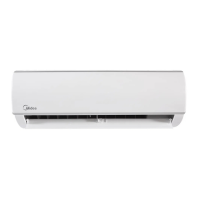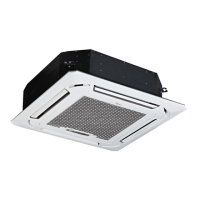
Do you have a question about the Midea MOA1-09HN1-QC2 and is the answer not in the manual?
| Type | Split Air Conditioner |
|---|---|
| Cooling Capacity | 9000 BTU/h |
| Refrigerant | R410A |
| Weight (Indoor Unit) | 8 kg |
| Weight (Outdoor Unit) | 23 kg |
| Noise Level (Outdoor Unit) | 52 dB(A) |
| Power Supply | 220-240V, 50Hz |
General instructions to prevent injury and property damage.
Critical warnings regarding installation and electrical safety.
Important notes and warnings for installation and operation.
Lists indoor and outdoor unit model names by capacity.
Dimensions and installation hole details for various indoor unit models.
Dimensions and installation clearances for outdoor units.
Diagram illustrating the refrigerant flow for cooling-only models.
Diagram illustrating the refrigerant flow for heat pump models.
Wiring schematics for various Midea indoor unit models.
Wiring schematics for various Midea outdoor unit models.
Torque specifications for pipe connections during installation.
Guidelines for selecting appropriate power cords based on current.
Specifications for refrigerant pipe length and elevation differences.
Procedures for initial installation including leak testing and evacuation.
Detailed steps for adding refrigerant to an existing system.
Procedure for collecting refrigerant before indoor unit repair.
Procedures for system evacuation and refrigerant charging during re-installation.
Important operational warnings and conditions for optimal performance.
Definitions of common temperature and sensor abbreviations.
Explanation of icons displayed on the indoor unit control panel.
Details on various protection features like time delay, fan speed, current, and communication errors.
Description of fan, cooling, heating, drying, auto, and forced operation modes.
Conditions and actions for the defrosting mode.
How the unit selects cooling, heating, or fan mode based on temperature.
Operation and rules for the drying mode.
How to use forced cooling and forced auto modes.
Explanation of timer on, off, and on/off functions.
Operation and duration of the sleep mode.
How the unit resumes operation after power failure.
Table mapping operation lamps to specific error conditions.
Step-by-step troubleshooting guides for various error codes and issues.
Troubleshooting steps for sensor circuit errors.
Troubleshooting for over current protection faults.
Troubleshooting for EEPROM parameter errors.
Troubleshooting for zero crossing detection errors.
Troubleshooting for communication errors between units.











